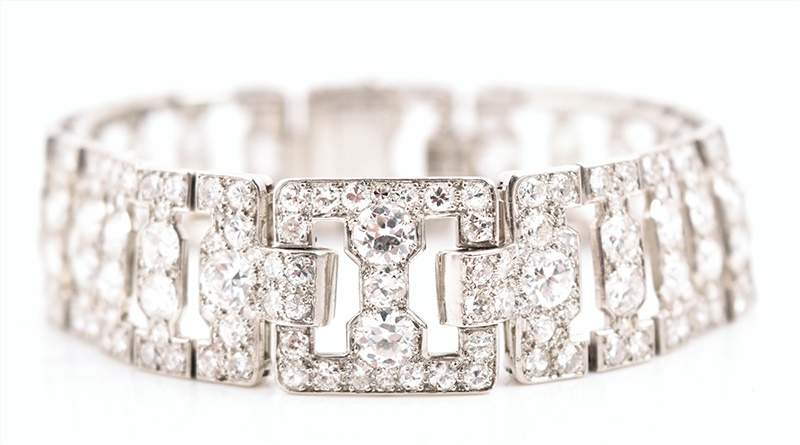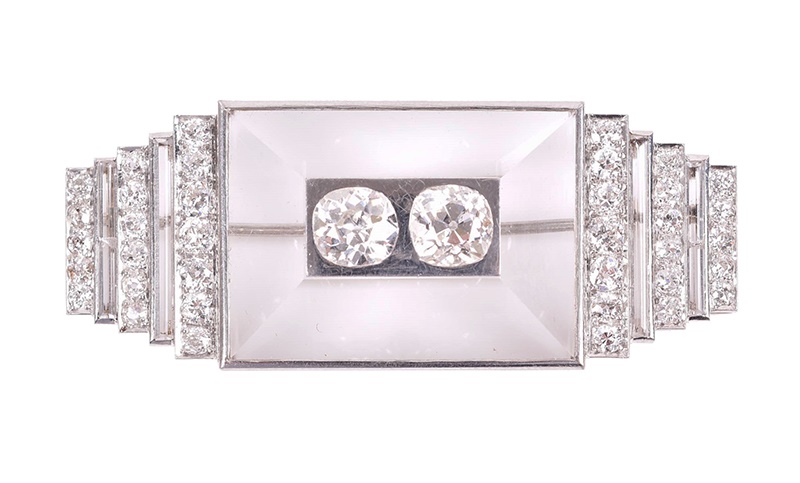How Do I Identify Art Deco Jewellery?
Familiarise yourself with the key features and influences of Art Deco jewellery
19/10/2023
Jewellery produced during the Art Deco period remains some of the most iconic, desired, and reproduced styles in history. A decadent era represented by transition, modernisation, and bold creativity, in 1910 the Art Deco movement emerged in Paris, but only gained full global momentum in the 1920s following the end of World War I, spanning right through to the end of the 1930s when World War II broke out. The movement influenced everything from architecture to art to fashion.
 A French Art Deco platinum and multi gem Egyptian revival pendant
A French Art Deco platinum and multi gem Egyptian revival pendant
Cubism, Futurism, and the age of machines, at first glance a genuine piece of Art Deco jewellery will represent a distinct style characterised by geometric forms and symmetry. Jewellery created in shapes such as circles, triangles, squares, and rectangles, or indeed featuring individual details in this form are an initial indication of origin. Art Deco jewellery is often symmetrical and streamlined meaning there is a clear balance of lines, gemstones, and design arrangements.
A key feature of Art Deco jewellery is the emphasis on bold colours and contrast. This can be seen in the use of vibrant gemstones such as emeralds, rubies, and sapphires, set against contrasting white diamonds, black onyx, or red coral in metals such as platinum, white gold and silver. The type of cut of the stones used were antique cushion cut, transitional cut, calibre cut, Asscher cut and old European cut, with some gemstones carved or polished into cabochons.
 A Cartier London Art Deco diamond bracelet
A Cartier London Art Deco diamond bracelet
In addition to geometric shapes and bold colours, Art Deco jewellery often incorporates influences from Oriental, Egyptian and Aztec cultures. These influences can be seen in the use of motifs such as lotus flowers, pagodas, and scarabs.
Filigree details are common, originally made with delicate threads of precious metal hand-manipulated into intricate designs, the industrialisation of this era perfected the use of die-cut stamps to achieve this effect for mass production. The vast majority of filigree work was in 10 or 18 carat white gold, modern reproductions tend to be in 14 carat white gold and often display a yellowish tone, whereas old gold has a greyer appearance in its’ natural state.
 An Art Deco diamond plaque brooch by Suzanne Belperron and Rene Boivin
An Art Deco diamond plaque brooch by Suzanne Belperron and Rene Boivin
Hinges, clasps, and catches can also provide invaluable clues as to the age of a piece of jewellery. For example, the presence of a modern lobster clasp is an almost certain indication of a reproduction piece.
When identifying Art Deco jewellery, look for pieces that exhibit these characteristics. Pay attention to the overall design - is it symmetrical with clean lines? Are there geometric patterns or motifs present? Is there a strong use of contrasting colours? By familiarising yourself with these key features and influences of Art Deco jewellery, you'll be better equipped to identify and appreciate this iconic style from one of the most influential periods in design history.
read more
The Complete Guide to Cartier Art Deco Jewellery
How Do I Know if My Jewellery is Valuable?
Do you have any Art Deco jewellery that you are considering selling?
Streaming live to over 10 million bidders, Dawsons can place your jewellery in a global shop window
We would be delighted to help you achieve the best price at auction
Please get in touch with our Specialists today for free sales advice: